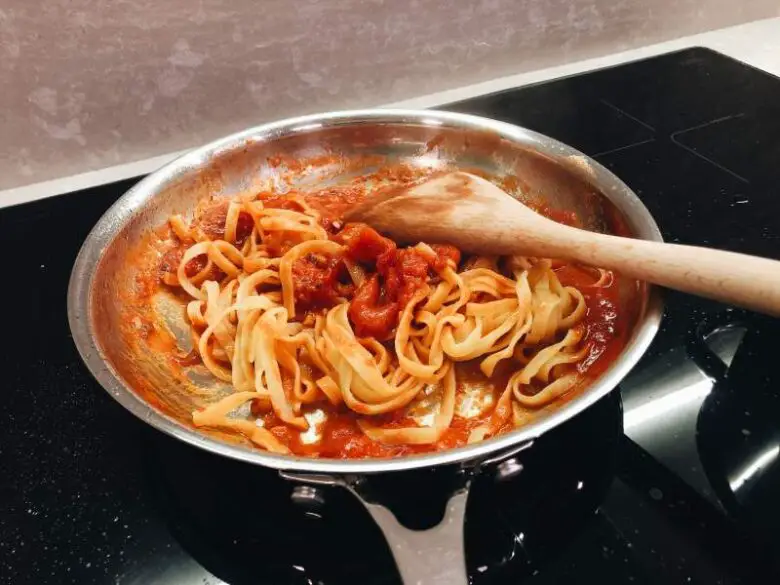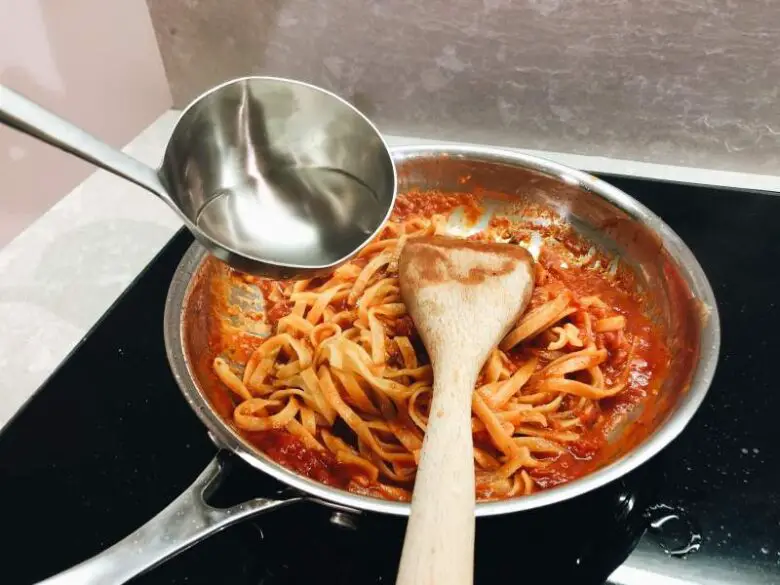Pasta is a staple in American homes. Made of flour, water, and, occasionally, egg, pasta noodles come in all shapes and forms. They can also be cooked in a variety of sauces and paired with a practically limitless number of ingredients.
According to Share the Pasta, the average American consumes 20 pounds of pasta noodles per year. This turns pasta into the sixth most eaten food in the U.S. When you put the numbers together, this means that Americans consume about 5.95 billion pounds of pasta per year.
With so much pasta eaten every year, you’d think we’ve perfected the techniques and recipes for cooking it a long time ago. Yet that’s not necessarily the case.
Cooking tasty pasta dishes can be hard to do—especially for the novice cook. Which is why, in this post, I’m going to share with you 8 simple but powerful ways to make your pasta dishes taste better.
1. Use Bronze-Die Pasta
The dried pasta packs that you and I buy at the store are made at pasta factories on a commercial scale. Machines mix flour and water into a dough, then push it through a mold that pasta producers called “die.” The die cuts the pasta noodles in different shapes and forms.
Some of the biggest pasta factories produce as much as 1,400 tons of pasta noodles a day. And, when it comes to the quality of your pasta, the devil is in the details. Or, should I say, in the die.
Pasta dies are typically coated with one of two materials: bronze or non-stick. Bronze is the more traditional coating—it’s rougher and it produces pasta with a slightly more porous surface. Non-stick, on the other hand, is the more modern coating which produces sleeker pasta.
As the name suggests, bronze-die pasta is pasta that’s been produced by bronze die. Compared to its non-stick-die counterpart, it has a richer golden color and a more porous surface. This helps the sauce to cling better onto the noodles, producing tastier pasta.
To check out my picks for bronze-die pasta, head over to my post, The Best Italian Pasta Brands in Grocery Stores.
2. Cook the Noodles in Salty Water
Your noodles came out tasting bland? It’s probably because you forgot to salt the water.
There’s a saying among Italian chefs that “pasta water should taste like the sea.” Though not all of us taste seawater for a living, they do have a point. With a salinity of 38-40 g/kg (parts per thousand), the Mediterranean sea is pretty salty. And cooking pasta in generously salted water yields tastier noodles.
Boiling pasta is as much about rehydrating the noodles as it is about cooking them through. Fresh pasta has a moisture content of approximately 30% and dried pasta of 12.5%. Pasta is made of water and flour. And flour consists of two building blocks—gluten (a wheat protein) and starch (a plant carbohydrate).
When flour (and flour goods) comes into contact with a liquid, the starch and gluten soak up the moisture from that liquid. On average, flour can absorb as much as 55-65% of its own weight in water. By adding pasta noodles in a pot of water, boiling or cold, you’re allowing the noodles to rehydrate by absorbing moisture.
Salt, on the other hand, is water-soluble. If you generously salt a pot of water and add pasta noodles to it, the noodles will gradually absorb salty water as the dough rehydrates. As a result, they’ll come out well seasoned and tasting fantastic.
Just how much salt should you add to your pasta water? Follow the 1:1:4 ratio. For every 1 pound of pasta, add 1 tablespoon of salt, cooking in 4 quarts of boiling water.
3. Cook the Noodles “al Dente”
Pasta chefs in Rome slightly undercook the pasta by straining it from the water when it’s cooked through on the inside, but still slightly firm to the bite and slightly crunchy on the outside. They call this technique for cooking noodles al dente, which translates as “to the tooth.”
Al-dente pasta holds on to its shape better, has a chewier texture, and is easier to digest. Noodles cooked firm to the bite have a lower glycemic index than ones that are overcooked.
This means that your stomach digests them slowly and steadily, using them as a gradual source of energy for hours (instead of causing you to feel beat and tired down). If you’ve ever wondered how Italians can eat pasta all day and not feel slouchy, the answer is in this cooking technique.
You can replicate it at home by cooking the noodles for 2-3 minutes less than the recommended cooking time in the instructions on the package. Or you can learn all about it in my post on the topic, This Is How to Tell When Pasta Is Cooked.
4. Sauce the Pasta in the Pan
This is one of the simplest techniques for making pasta taste better on my list, yet it’s also one of the most powerful. Here’s how it works (and why it works so well).
Think of yourself as a painter and of the pasta noodles as a blank canvas. You added the contours to your painting by cooking the pasta in generously salted water. The pasta sauce is your paint. The better you spread the paint on the canvas, the more colorful your picture.
Okay, Jim, enough with the metaphors. A pasta dish tastes noticeably better if you mix the noodles with the sauce before you plate them.
The no. 1 mistake novice cooks make when making pasta dishes is to not mix the noodles in the sauce before putting them on the plate. Just look at the difference:

Different people will have different techniques for doing this. Mine is to:
- Cook the sauce in a frying pan over medium heat as I’m boiling the noodles in a rolling boil in a pasta pot;
- Once the noodles are cooked al dente, strain them from the pasta water and transfer them to the frying pan;
- Bring the heat down to low and mix the noodles with the sauce in the frying pan, stirring and tossing the pasta dish in my pan;
- After 1 minute, plate the pasta and serve.
Try this technique out the next time you make pasta. The chunky tomato sauce will hide in the small nooks and crannies of the noodles—and create nothing short of an explosion of flavor in your mouth when you get down to eating the pasta dish.
Here’s how this process looks like:

5. Make a Base for the Sauce
Cooking is all about layering taste. And the “base” of a dish is the foundational flavor on which you’re layering the rest of your dish.
By themselves, canned tomatoes taste great. But layer the acidic and slightly sweet taste of canned tomatoes with the pungent aroma of garlic and the bitterness of extra virgin olive oil, and you have yourself a tastier pasta sauce.
Brown thick cubes of guanciale (cured pork jowl), pancetta (cured pork belly), or bacon before you add the garlic and tomatoes to the frying pan, and you have a salty, briny, and meaty pasta sauce. Sweat a couple of onions or add 1-2 prunes for extra sweetness.
You get the drill. If you make a really delicious sauce (and follow the rest of the tips in this post), you’re going to make delicious pasta. Conversely, you can boil the most perfect pasta noodles, yet make the blandest pasta dish by not making a savory and luscious sauce.
6. Add Pasta Water to the Sauce
An easy way to make any pasta sauce taste better, store-bought or homemade, is to add 1 soup ladle of pasta sauce 2-3 minutes before you’re done cooking it.

Some food writers call pasta water “liquid gold,” and I tend to agree with them. Salty, starchy, and viscous, pasta water helps to thicken your sauce once you cook it down and adds a wheaty pasta flavor to it (the same flavor that the pasta noodles released into the water).
7. Add Fresh Herbs to the Sauce
Nothing can brighten up a pasta sauce as well as fresh basil or fresh oregano leaves. Fresh herbs contain aromatic essential oils packed with potent flavor.
Most fresh herbs, like basil and oregano, are tender. You can easily cook off their flavors if you add them to the frying pan too early.
For best results, add fresh herbs to your pasta sauce approximately 15-30 seconds before you’re done cooking, stirring it well to incorporate the aroma and flavor.
8. Grate Cheese on Top of the Pasta
Finish off your pasta dish by grating a hefty amount of hard, salty, and savory Italian cheese on top of it. My personal favorites are Parmigiano-Reggiano and Pecorino Romano.
Parmigiano-Reggiano is a hard and crumbly Italian cheese made of cow’s milk and aged for at least 12 months. Pecorino Romano is a hard and flaky, slightly greasier, cheese made from goat’s milk. Compared to Parmigiano-Reggiano, it’s considerably saltier and tangier.
Don’t buy pre-grated cheese. Compared to cheese blocks (vacuum-sealed or from the cheese counter at the grocery store), pre-grated cheese contains additives to keep it from caking and molding.
Though manufacturers claim that these additives are safe, you can go without them by buying cheese in blocks and grating it yourself.
Conclusion
There you have it. These eight simple but powerful techniques will help you to make tastier pasta dishes every single time you cook at home.
Try out at least a couple of these techniques (or, even better, try them out all together) and let me know how they worked out for you in the comments below.

